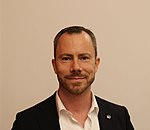Venstre (Denmark)
|
Venstre - Danmarks Liberale Parti Linke - Liberal Party of Denmark |
|

|
|

|
|
| Party leader | Jakob Ellemann-Jensen |
| Group chairmanship in the Folketing | Kristian Jensen |
| Political spokeswoman | Ellen Trane Nørby |
| Party secretary | Claus Søgaard-Richter |
| founding | 1870 |
| Alignment |
liberal - conservative centrist |
| Headquarters | Fetched |
| Number of members | 35,957 (2016) |
| Youth association | Venstres Ungdom |
| Electoral list | V |
| Sit in the Folketing |
42/179 |
|
International connections |
Liberal International |
| MEPs |
4/14 |
| European party | ALDE |
| EP Group | RE |
| www.venstre.dk | |
Venstre - Danmarks Liberale Parti (party letter V , Danish for Left - Liberal Party of Denmark ) is a conservative-liberal political party in Denmark . In German usage, the term Liberal Party is used. Contrary to its name, which comes from its classification in the political spectrum in the late 19th century, when the party emerged, the party is assigned to the center-right camp.
history
The "United Venstre" was formed in 1870 from various groups in the Reichstag, which mainly represented small and large peasant interests and were in opposition to aristocratic landlords and national liberals . From 1872 Venstre had a majority in the Folketing , but was excluded from forming a government. By 1878/80 at the latest, the Venstre was split into up to five camps. The question of how to confront the J. B. S. Estrup government (1875–94) in parliament provoked time and again conflicts: The “Moderate Venstre” relied on negotiations, the “Volks-Venstre” (Det folkelige Venstre) on confrontation. After the moderates had agreed to a military fortification of Copenhagen in 1894, for which the conservative ruling party Højre had to forego Estrup in return, the supporters of an uncompromising opposition course founded the "Venstre Reform Party". This party also split, the left-wing liberals founded Det Radikalische Venstre in 1905 , while the rest of them united with the moderates to form Venstre, which still exists today.
In 1901 the parliamentary majority principle could be anchored in the political system. Venstre provided several prime ministers at the beginning of the 20th century, but lost the leadership position to the Social Democrats in the mid-1920s . However, for many decades it retained a lead over the other bourgeois party, the Conservatives . It was not until the 1980s that Venstre fell back significantly and only received 10 percent of the vote. A rapid ascent followed in the 1990s. From 2001 to 2015 the Venstre was again the strongest party in Denmark.
After the Second World War , the Liberals were able to provide the head of government six times (1945–47, 1950–53, 1973–75, 2001–09, 2009–11 and since 2015). In addition, they participated as a smaller partner in coalition governments 1968–71, 1978–79 and 1982–93. Traditionally, the strongholds of the party are in the rural areas, while the metropolitan constituencies in Copenhagen are difficult terrain.
In the 1990s, ex-foreign minister Uffe Ellemann-Jensen gave his party a sharper, liberal profile, thereby separating it more clearly from the rest of the bourgeois camp. His charismatic demeanor brought him new followers, especially among young voters. After Ellemann-Jensen narrowly missed a change of government in 1998, he left Anders Fogh Rasmussen to chair the party. Fogh Rasmussen was able to win votes in 2001 primarily with a campaign for a stricter immigration policy; 31.3% meant the best result in 80 years. From 2001 to 2011 Venstre formed a minority government with the Conservative People's Party . In the 2005 and 2007 elections, the party suffered a slight loss of votes, but was able to maintain the government majority with its allies. In 2011, however, Venstre was able to grow slightly, but had to leave the formation of a government to the Social Democrats.
In the 2015 Folketing election , Venstre suffered significant losses of over seven percentage points and was only the third strongest force with 19.5 percent, as it was overtaken by the Social Democrats and for the first time by the Danish People's Party . Nevertheless, the bourgeois camp was able to achieve a majority in parliament. Due to the majority situation, Venstres top candidate Lars Løkke Rasmussen was commissioned to form a government. The explorations did not lead to the formation of a majority coalition, so the Venstre minority government Løkke Rasmussen II was formed. It is supported in parliament by the other parties in the bourgeois camp. Lars Løkke Rasmussen was appointed Prime Minister by the Queen on June 28, 2015.
Positions
A study from 2019, which looked at the voting behavior of parties on climate policy issues in the EU Parliament, rated Venstre as a “delay” in climate-friendly politics.
Folk elections
Since the introduction of proportional representation in 1918 (source: Folketingets Oplysning )

Party leader
The party leader has a strong position within the organization. In times of great power, the press and the public liked to refer to him as “chief” (Venstre-høvding) . The radical Venstre , split off in 1905, uses a diametrically opposed leadership model.
- Thomas Madsen-Mygdal , 1929–1941
- Knud Kristensen , 1941–1949
- Edvard Sørensen , 1949-1950
- Erik Eriksen , 1950–1965
- Poul Hartling , 1965-1977
- Henning Christophersen , 1977–1984
- Uffe Ellemann-Jensen , 1984-1998
- Anders Fogh Rasmussen , 1998-2009
- Lars Løkke Rasmussen , 2009–2019
- Jakob Ellemann-Jensen , since 2019
literature
- Alfred Jüttner / Hans-J. Liese: Paperback of the European parties and elections . Olzog, Munich 1977.
Web links
Individual evidence
- ↑ Membership figures 2016 Folketingets Oplysning, accessed on October 28, 2018.
- ^ Alfred Jüttner / Hans-J. Liese, pp. 173/174.
- ^ Rasmussen wants to form minority government Time, June 21, 2015.
- ↑ Denmark's new prime minister presents liberal cabinet before Handelszeitung, June 28, 2015.
- ↑ http://www.caneurope.org/docman/climate-energy-targets/3476-defenders-delayers-dinosaurs-ranking-of-eu-political-groups-and-national-parties-on-climate-change/file
